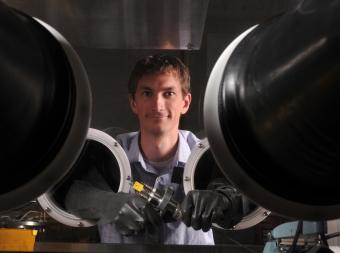Harnessing data for materials discovery goal of new $15M NSF Institute for Data-Driven Dynamical Design
Colorado School of Mines' Eric Toberer is leading the institute, 1 of 5 Harnessing Data Revolution Institutes funded nationwide

Eric Toberer, associate professor of physics and director of the Materials Science Program at Colorado School of Mines, is leading the $15 million NSF Institute for Data Driven Dynamical Design (ID4).
Scientists and engineers are constantly on the hunt for novel materials and structures that combine valuable properties in new ways.
But what if they could harness the power of data science to discover fundamentally novel materials – for everything from carbon dioxide separation to better fuel cells to earthquake-proof buildings – at a far more accelerated pace?
A new $15 million interdisciplinary research institute led by Colorado School of Mines aims to create new theoretically grounded and experimentally validated approaches and tools to design and discover dynamical materials and structures while solving long-standing scientific challenges in the dynamical response of materials.
The NSF’s Institute for Data Driven Dynamical Design (ID4) is one of five new Harnessing Data Revolution Institutes funded through a $75 million investment announced today by the National Science Foundation to enable new modes of data-driven discovery that allow fundamental questions to be asked and answered at the frontiers of science and engineering.
The Mines-led institute brings together data scientists, engineers, physicists, chemists and material scientists from 11 other institutions across the U.S.: Northeastern University; University of Illinois Urbana-Champaign; Drexel University; Northwestern University; University of California, Los Angeles; University of Central Florida; Harvard University; Princeton University; Washington University in St. Louis; Tufts University; and industry partner Kebotix, Inc.
“Over the last decade, we’ve seen major advancements in using big data to predict new materials. What makes this institute different is a focus on the discovery of new pathways and mechanisms rather than just targeting a final property. This is crucial if you want to move beyond incremental improvements and interpolation – by analogy, if you knew how to swim a doggie paddle and a backstroke, you're not going to interpolate to the dolphin stroke,” said Eric Toberer, director of the Materials Science Program at Colorado School of Mines and lead investigator on the institute. “We’re excited to develop exploratory search methods for finding new dynamics. In the long term, such dynamics might ultimately involve materials, macroscopic structures, biology, geophysics or even finance.”
To do that, the institute will address three core data science needs: new representations and learning architectures that capture the time evolution of complex materials; efficient exploration of time-dependent design spaces; and new visual analytics tools to incorporate human feedback into the design process.
The initial focus for material discovery will be four spaces already at a “tipping point,” where large quantities of dynamical data can be readily created: crystalline solids with tailored ion transport for fuel cells and batteries; pressure-sensitive metamaterials for robotics; light driven catalytic reactions for chemical production; and synthesis and assembly of porous frameworks for chemical separations.
The ultimate goal, Toberer said, is to develop algorithms and mechanisms that are cross-cutting enough to be able to solve a wide variety of material challenges in complex time-evolving systems.
“We’re very agnostic to the application – in the near term we are interested in better materials and reactions, but long term, we’re also trying to create open-source software that will help people beyond this team,” Toberer said. “It would be a disaster if we wrote something that was so specialized it could only solve one problem.”
Among the members of the interdisciplinary research team are experts in machine learning, knowledge structures and visualization, as well as organic chemistry and catalysis, ion and gas transport, metamaterials and structural materials. Co-PIs are:
- Ryan P. Adams, Professor of Computer Science at Princeton University
- Sigrid Adriaenssens, Associate Professor of Civil and Environmental Engineering at Princeton University
- Katia Bertoldi, William and Ami Kuan Danoff Professor of Applied Mechanics at Harvard University
- Remco Chang, Associate Professor of Computer Science at Tufts University
- Adji Bousso Dieng, Tenure-Track Assistant Professor of Computer Science at Princeton University
- Abigail Doyle, Saul Winstein Chair of Organic Chemistry at University of California, Los Angeles
- Elif Ertekin, Associate Professor of Mechanical Science and Engineering and Andersen Faculty Scholar at University of Illinois Urbana-Champaign
- Roman Garnett, Associate Professor in the Department of Computer Science & Engineering at Washington University in St. Louis
- Diego Gomez-Gualdron, Assistant Professor of Chemical and Biological Engineering, Colorado School of Mines
- Jane Greenberg, Alice B. Kroeger Professor and Metadata Research Center Director, College of Computing & Informatics at Drexel University
- Sossina M. Haile, Walter P. Murphy Professor of Materials Science and Engineering and of Applied Physics at Northwestern University
- Boris Kozinsky, Associate Professor of Computational Materials Science at Harvard University
- Steven Lopez, Assistant Professor in the Department of Chemistry & Chemical Biology at Northeastern University
- Alvitta Ottley, Assistant Professor in the Department of Computer Science & Engineering at Washington University in St. Louis;
- Semion K. Saikin, Chief Science Officer at Kebotix, Inc.
- Fernando Uribe-Romo, Associate Professor of Chemistry at University of Central Florida
The institute’s work will also include a robust outreach program, including summer coding schools for high school students, undergraduate research opportunities, and one-year internships for recent college graduates who attended schools without undergraduate research programs. In the later years of the five-year program, the institute also plans to offer graduate student fellowships, where doctoral students from universities not affiliated with the institute could come and learn the tools, contribute to their development and then bring them back to their own labs.




